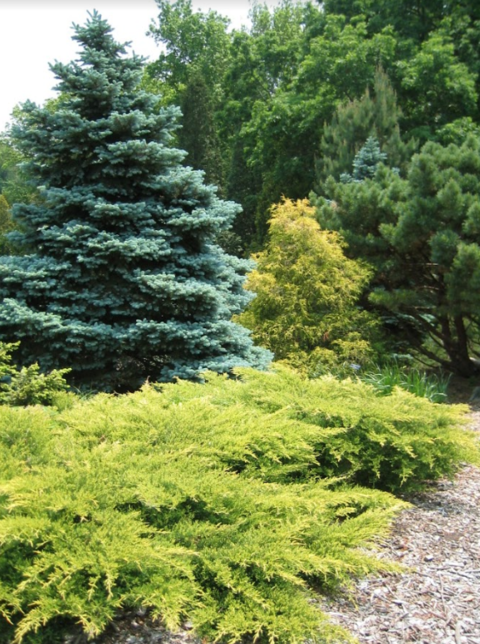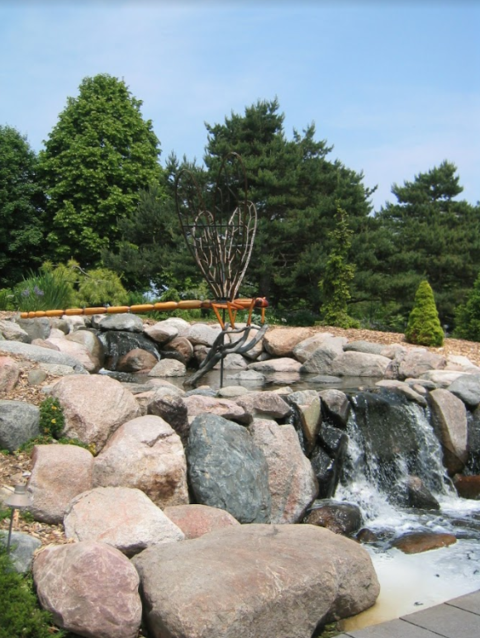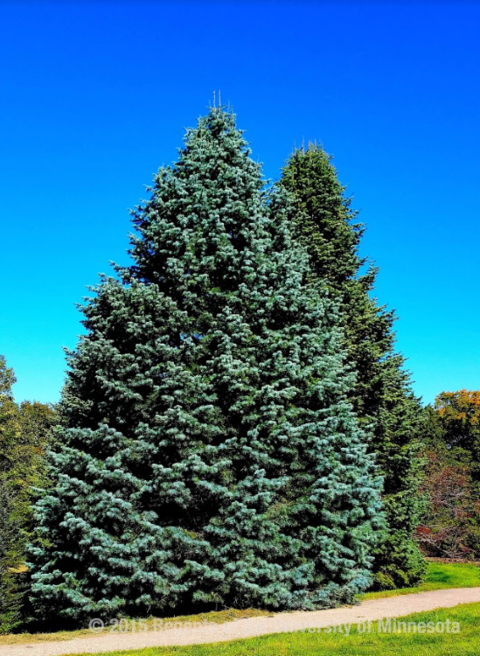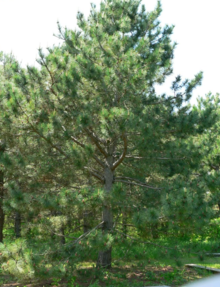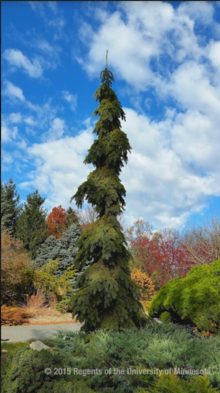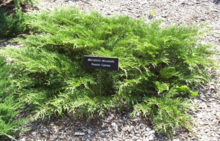Choosing evergreens for your landscape
Planting and caring for evergreens takes an investment of time and money, and so it is important to make the right decisions when choosing these plants for your yard.
To choose evergreen trees and shrubs for Minnesota landscaping, you need to be familiar with your growing conditions — hardiness zone, light, soil type, space for planting — and what type and form of evergreen you would like to plant.
Evergreens can be conifers (cone-bearing, needle-like foliage) such as pine, spruce, juniper, or arborvitae. They can also be broadleaf (leaf-like foliage) such as boxwood and rhododendron.
Nursery grown evergreens are slow growing and can be expensive due to years of care needed to produce well-shaped tops and ample root systems before trees are sold. More years of care will be required after the evergreen is transplanted to a landscape.
If you make the right choice at the beginning, not only will you save time and money, but your landscape evergreens will provide years of pleasure.
Growing conditions
- Cold hardiness zones 3 and 4, and some zone 5 in Minnesota.
- Avoid extreme exposure to northwest winter winds and southern exposures.
- Moist, fertile, well-drained soil.
- Soil pH of neutral (7.0) to slightly acidic pH (6.0-7.0).
Some evergreens are tolerant of less than ideal growing conditions. Always choose plants with growing requirements that match the conditions of your landscape.
Size
- Spruce, fir and arborvitae are pyramid-shaped evergreens that may cover a circle 30 feet in diameter when they reach full maturity.
- Pines are also pyramid-shaped as young trees, but as they mature they often lose lower branches, resulting in open space beneath.
- Depending on the species, pines can reach 50 feet or more in height.
- Pine roots fill a large circle of soil under their foliage, making it difficult to grow turf and other plants underneath these trees.
- Boxwoods can be sheared to maintain a globe or hedge form. If left unsheared, they have a spreading upright form.
- Rhododendrons are upright, spring-blooming shrubs. They have dark green leaves that stay attached to the plant through winter when they turn a darker green to bronze color.
- Smaller upright junipers or columnar arborvitae are often more in scale with residential sites. These evergreens will mature at 20 to 30 feet, with a spread of 5 to 10 feet, depending on the variety.
- Juniper shrubs with horizontal shapes can spread to 5 or 6 feet in a few years.
- Heights vary considerably according to the variety.
- An 18-inch high skandia juniper is far more useful under a ground level window than its 5-foot relative, savin juniper.
- Japanese yews are often pruned tightly to keep them at a desired height or width, but some selections will grow into 20-foot trees or very wide shrubs over time.
Form, color and texture
Evergreens come in many different forms: pyramid shape, spreading, open, prostrate or creeping, mounded, rounded, upright, weeping.
Evergreens also provide year-round color and texture in a landscape making them excellent accent plants. This is an important plant characteristics in Minnesota and other areas with long winters.
When choosing evergreens consider:
- Foliage, bark, cones, berries.
- Sunlight is important to maintaining foliage color.
- Age of the growth may affect color.
- Some options:
- Silvery blue juniper varieties
- Dark green Japanese yew; the female plants bear red berries
- Scotch pines' cinnamon orange bark and bluish green needles
- Purplish brown eastern red cedars
- Deep green spruce or balsam fir
- For good visual appeal, avoid combining evergreens with the same or very similar colors, textures and forms.
Evergreens for difficult sites
- Clay soil — arborvitae, Austrian pine, ponderosa pine, white fir
- Sandy soil — Scotch pine, mugo pine, junipers
- Wet soil — American arborvitae, balsam fir, black spruce
- High pH — arborvitae, black hills spruce, mugo pine, ponderosa pine, junipers
- Windy, exposed — Black Hills spruce, jack pine, mugo pine, red pine, ponderosa pine, Rocky Mountain juniper, savin juniper, eastern red cedar, douglas fir
- Partial sun — arborvitae, balsam fir, douglas fir
- Shade — Canada hemlock, Canada yew, Japanese yew
Colorado blue spruce - Not recommended
Colorado blue spruce (Picea pungens) is no longer recommended for Minnesota landscapes due to its susceptibility to several debilitating spruce diseases, most specifically Rhizosphaera needle cast and Cytospora canker.
Concolor fir (Abies concolor) and some white spruce are good large tree alternatives with blue-green foliage to Colorado spruce. There are also some blue spruce dwarf cultivars that are on the market as well, such as ‘Fat Albert’ (15 feet tall by 3 feet wide).
Disease and insect problems
No tree or shrub is completely immune to insect or disease attack, but you can reduce pest issues:
- Choose plants with growing requirements that match your site conditions.
- Plant disease resistant cultivars and varieties.
- Keep plants healthy through sufficient watering, healthy soil, and fertilizing according to a soil test.
- Consult UMN Extension Master Gardener volunteers or local nurseries about pest problems with any evergreen tree or shrub you are considering.
Best evergreens for northern climates
The following is a list of just some of the evergreens suitable for Minnesota landscapes. Be sure to visit your local garden center or plant nursery for more that may be available in your area.
-
Red pine (Pinus resinosa): 80 feet tall by 40 feet wide, medium growth rate, upright form, full sun; the state tree of Minnesota. Also called Norway pine
-
Tannenbaum Mugo pine (Pinus mugo var. uncinata 'Tannenbaum'): 12 feet tall by 6 feet wide, slow growth rate, compact pyramidal form, full sun
-
Norway spruce (Picea abies): 80 feet tall by 30 feet wide, medium-to-fast growth rate, pyramidal form, full sun
-
Russian cypress (Microbiota decussata): 1 foot tall by 4 feet wide, slow growth rate, low spreading form, full sun to full shade
-
Weeping white spruce (Picea glauca ‘Pendula’): 50 feet tall by 10 feet wide, slow growth rate, vertical form, full sun, drooping branches
-
Fastigiata spruce (Picea pungens var. glauca 'Fastigiata'): 15 feet tall by 3 feet wide, slow growing, narrow columnar form, full sun
-
Concolor fir (Abies concolor): 60 feet tall by 24 feet wide, slow-to-medium growth rate, pyramidal form, full sun, blue foliage - good substitute for Colorado blue spruce
-
Ponderosa pine (Pinus ponderosa): 70 feet tall by 40 feet wide, medium growth rate, pyramidal form, full sun
-
Scotch pine (Pinus sylvestris): 50 feet tall by 30 feet wide, slow-to-medium growth rate, pyramidal form, full sun
-
Eastern White pine (Pinus strobus): 80 feet tall by 40 feet wide, medium growth rate, pyramidal form, full sun to part sun
-
Balsam fir (Abies balsamea): 60 feet tall by 24 feet wide. slow growth rate, pyramidal form, full sun to part shade
-
Black Hills spruce (Picea glauca var. densata): 40 feet tall by 35 feet wide, slow growth rate, pyramidal form, full sun to part sun
-
Globe Arborvitae (Thuja occidentalis ‘Woodwardii’): 6 feet tall by 8 feet wide, slow-to-medium growth rate, rounded form, full sun to part shade
-
Techny Arborvitae (Thuja occidentalis ‘Techny’): 15 feet tall by 15 feet wide, slow-to-medium growth rate, pyramidal form, full sun to part shade
-
Canada hemlock (Tsuga canadensis): 40 feet tall by 25 feet wide, medium growth rate, pyramidal form, full sun
-
Savin juniper (Juniperus sabina ‘Savin’): 6 feet tall by 5 feet wide - slow growth rate, 5 feet tall by 10 feet wide, compact, upright form, full sun
-
Rocky Mountain juniper (Juniperus scopularum): 15 tall by 8 feet wide, slow growth rate, conical, upright form, full sun
-
Austrian pine (Pinus nigra) - 40 feet tall by 45 feet wide, medium growth rate, pyramidal form, full sun
-
Douglas fir (Pseudotsuga menziensii; not a true fir) - 60 feet tall by 35 feet wide, medium growth rate, pyramidal form, full sun
-
Wilton Carpet juniper (Juniperus horizontalis ‘Wiltonii’) - 1 foot tall by 6 feet wide, slow-to-medium growth rate, spreading form, full sun, blue-green foliage
-
Prince of Wales juniper (Juniperus horizontalis ‘Prince of Wales’) - 1 foot tall by 5 feet wide, slow-to-medium growth rate, spreading form, full sun
-
Green Sargent juniper (Juniperus chinensis sargentii ‘Viridis’) - slow-to-medium growth rate, 2 feet tall by 8 feet wide, spreading form, full sun
-
Sea Green juniper (Juniperus chinensis ‘Sea green’) - 6 feet tall by 6 feet wide, slow to medium growth rate, arching, spreading form, full sun, bright green year round
-
Old Gold juniper (Juniperus chinensis ‘Old Gold’) - 3 feet tall by 5 feet wide, slow growth rate, spreading form, new growth is golden yellow, full sun
-
Japanese Spreading yew (Taxus cuspidata) - 5 feet tall by 6 feet wide, slow growth rate, large spreading form, part sun to full shade
-
Japanese Dwarf yew (Taxus cuspidata ‘Nana’) - 3 feet tall by 5 feet wide, slow growth rate, pyramidal, rounded form, part sun to full shade
-
Taunton Spreading yew (Taxus x media ‘Tauntonii’) - 4 feet tall by 6 feet wide, slow growth rate, spreading form, full sun to full shade
-
P.J.M. rhododendron (Rhododendron ‘P.J.M.’) - 5 feet tall by 5 feet wide, slow to medium growth rate, upright rounded form, part sun
-
Purple Gem rhododendron (Rhododendron X ‘Purple Gem’) - 3 feet tall by 3 feet wide, slow growth rate, compact rounded form, part shade
-
Chicagoland Green® Boxwood (Buxus ‘Glencoe’) - 4 feet tall by 5 feet wide, slow growth rate, oval broad form that sheared for hedge and topiary, full sun to part shade
-
Wintergreen Littleleaf boxwood (Buxus microphylla ‘Wintergreen’) - 2 feet tall by 3 feet wide, slow growth rate, upright and spreading form that can be sheared, copper winter foliage, full sun
Table: Broadleaf evergreens for Zone 4
| Botanical Name | Common Name | Height | Comments |
|---|---|---|---|
| Arctostaphylos uva-ursi | common bearberry | 6-12" | Prostrate native shrub with small, thick persistent leaves; small red berries; may be hard to find at garden centers. |
| Bergenia cordifolia | pig squeak, bergenia | 12-18" | Bronze/red winter foliage; often tattered and brown by spring; early spring pink flowers. |
| Buxus microphylla koreana | Korean boxwood | 2-4' | Hardy; good for low hedges and knot gardens; deep-green fine-textured foliage persists throughout winter; prefers well-drained soil; protect from winter sun and wind; 'Green Velvet' and 'Wintergreen' are good dwarf varieties. |
| Daphne x burkwoodii | 'Carol Mackie' daphne | 2-3' | Officially rated as USDA Zone 5; beautiful specimen plant; provide winter protection; often shortlived but well worth it. |
| Euonymus fortunei vegeta | bigleaf wintercreeper | under 1' | Can be grown as a groundcover, small shrub, or trained to a wall; flowers insignificant; needs protection from winter sun; do not plant where it can escape into a native area. |
| Kalmia latifolia | mountain laurel | 3-5' | Marginally hardy in Zone 4; attractive, leathery dark green leaves are maroon when emerging from the snow in spring; needs moist acidic site; 'Sarah' has large pinkish-red flowers. |
| Microbiota decussata | Russian cyprus | 1' x 6' | Low radiating arborvitae-like evergreen shrub; fan-like foliage changes from light green in spring to deep green in summer and bronze-brown in winter. |
| Pachysandra terminalis | Japanese spurge | 6-12" | Attractive whorls of evergreen foliage; good for under maple and other trees; 'Green Carpet' and 'Variegata' are common varieties; needs winter cover from sun and wind. |
| Rhododendron 'P.J.M.' | PJM rhododendron | 3-5' | Prefer acidic soil; tolerates light shade; lavender pink flowers in early spring; hardy to -35ºF. |
| Yucca filamentosa | yucca | 30" | Bold focal point; leaves are pointed and very sharp; drought and salt tolerant; flowers up to 5' tall. |
| Vinca minor | myrtle, periwinkle | 6-12" | Attractive thick foliage; showy blue flowers in spring; creeping stolons. |
Reviewed in 2018


